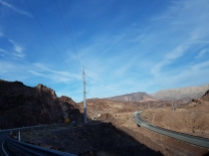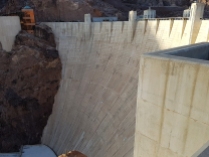Monday 31st October 2016. After our trip to Shelby Factory we set of for the next destination on the bucket list, the mighty Hoover Dam. We had to travel for a while, looking out of the air conditioned car windows at the heat haze and you realise that you are in a desert, with spectacular scenery. Most of the pictures to start with here were taken from inside the car.
The main road across the top of dam itself has a security check point, after which you travel around a few corners and then you see it.
It’s hard to comprehend the size and huge scale of the construction and how long it took to build.
The main car parks were full, so we had to park in an over spill area about a ten minute walk away up the hill-side. In fact it was a perfect vantage point to look down on the dam as it were.
Mart and Gary couldn’t resist a selfie by the sign for Arizona.
After our walk down to the top of the dam you notice two large clocks on the towers. The state line for Arizona and Nevada states crosses Hoover Dam. The clocks are also the boundary between the Mountain time zone and the Pacific time zone. During the part of the year that the country observes Standard Time, you can gain or lose one hour stepping across the line.
The first thing you will see is the spill ways that were in place to allow the lake to divert while the dam was being built.
The first thing you will notice is the white line above the lake. This was the original water line when the dam was first built. Current rate of use means that the dam turbines that produce the energy had to be upgraded to take into account the less water flow and pressure. Looking over the wall past the spill way you can see the original lake bed.
The turreted wall invites you to look over the edge, on doing so it can give you instant vertigo looking at the power generation side. Trucks and cars parked down below look like tiny specs in the distance! It’s a sight that will stay with you forever once you see it for the first time.
We have found some facts about the Hoover Dam, it was once known as Boulder Dam, and is a concrete arch-gravity dam in the Black Canyon of the Colorado River, on the border between the U.S. states of Nevada and Arizona. It was constructed between 1931 and 1936 during the Great Depression and was dedicated on September 30, 1935, by President Franklin D. Roosevelt. Its construction was the result of a massive effort involving thousands of workers, and cost over one hundred lives. The dam was controversially named after President Herbert Hoover.
Since about 1900, the Black Canyon and nearby Boulder Canyon had been investigated for their potential to support a dam that would control floods, provide irrigation water and produce hydroelectric power. In 1928, Congress authorised the project. The winning bid to build the dam was submitted by a consortium called Six Companies, Inc., which began construction on the dam in early 1931. Such a large concrete structure had never been built before, and some of the techniques were unproven. The torrid summer weather and lack of facilities near the site also presented difficulties. Nevertheless, Six Companies turned over the dam to the federal government on March 1, 1936, more than two years ahead of schedule.
Hoover Dam impounds Lake Mead, the largest reservoir in the United States by volume (when it is full). The dam is located near Boulder City, Nevada, a municipality originally constructed for workers on the construction project, about 30 mi (48 km) southeast of Las Vegas, Nevada. The dam’s generators provide power for public and private utilities in Nevada, Arizona, and California. Hoover Dam is a major tourist attraction; nearly a million people tour the dam each year. The heavily travelled U.S. 93 ran along the dam’s crest until October 2010, when the Hoover Dam Bypass (bridge) opened. The water flow rate has a maximum of 50,000 cubic feet per second!
River diversion
Before the dam could be built, the Colorado River needed to be diverted away from the construction site. To accomplish this, four diversion tunnels were driven through the canyon walls, two on the Nevada side and two on the Arizona side. These tunnels were 56 ft (17 m) in diameter. Their combined length was nearly 16,000 ft, or more than 3 miles (5 km). The contract required these tunnels to be completed by October 1, 1933, with a $3,000-per-day fine to be assessed for any delay. To meet the deadline, Six Companies had to complete work by early 1933, since only in late fall and winter was the water level in the river low enough to safely divert.
Tunnelling began at the lower portals of the Nevada tunnels in May 1931. Shortly afterwards, work began on two similar tunnels in the Arizona canyon wall. In March 1932, work began on lining the tunnels with concrete. First the base, or invert, was poured. Gantry cranes, running on rails through the entire length of each tunnel were used to place the concrete. The sidewalls were poured next. Movable sections of steel forms were used for the sidewalls. Finally, using pneumatic guns, the overheads were filled in. The concrete lining is 3 feet (1 m) thick, reducing the finished tunnel diameter to 50 ft (15 m). The river was diverted into the two Arizona tunnels on November 13, 1932; the Nevada tunnels were kept in reserve for high water. This was done by exploding a temporary cofferdam protecting the Arizona tunnels while at the same time dumping rubble into the river until its natural course was blocked.
Following the completion of the dam, the entrances to the two outer diversion tunnels were sealed at the opening and halfway through the tunnels with large concrete plugs. The downstream halves of the tunnels following the inner plugs are now the main bodies of the spillway tunnels. The inner diversion tunnels were plugged at approximately one-third of their length, beyond which they now carry steel pipes connecting the intake towers to the power plant and outlet works. The inner tunnels’ outlets are equipped with gates that can be closed to drain the tunnels for maintenance.
Concrete
Columns of Hoover Dam being filled with concrete, February 1934 (looking upstream from the Nevada rim)
The first concrete was poured into the dam on June 6, 1933, 18 months ahead of schedule. Since concrete heats and contracts as it cures, the potential for uneven cooling and contraction of the concrete posed a serious problem. Bureau of Reclamation engineers calculated that if the dam was built in a single continuous pour, the concrete would take 125 years to cool, and the resulting stresses would cause the dam to crack and crumble. Instead, the ground where the dam was to rise was marked with rectangles, and concrete blocks in columns were poured, some as large as 50 ft square (15 m) and 5 feet (1.5 m) high. Each five-foot form contained a series of 1-inch (25 mm) steel pipes; cool river water would be poured through the pipes, followed by ice-cold water from a refrigeration plant. When an individual block had cured and had stopped contracting, the pipes were filled with grout. Grout was also used to fill the hairline spaces between columns, which were grooved to increase the strength of the joins.
The concrete was delivered in huge steel buckets 7 feet high (2.1 m) and almost 7 feet in diameter; Crowe was awarded two patents for their design. These buckets, which weighed 20 short tons (18t) when full, were filled at two massive concrete plants on the Nevada side, and were delivered to the site in special railcars. The buckets were then suspended from aerial cableways, which were used to deliver the bucket to a specific column. As the required grade of aggregate in the concrete differed depending on placement in the dam (from pea-sized gravel to 9-inch or 23 cm stones), it was vital that the bucket be manoeuvre to the proper column. When the bottom of the bucket opened up, disgorging 8 cu yd (6.1 m3) of concrete, a team of men worked it throughout the form. Although there are myths that men were caught in the pour and are entombed in the dam to this day, each bucket only deepened the concrete in a form by an inch, and Six Companies engineers would not have permitted a flaw caused by the presence of a human body.
A total of 3,250,000 cubic yards (2,480,000 m3) of concrete was used in the dam before concrete pouring ceased on May 29, 1935. In addition, 1,110,000 cu yd (850,000 m3) were used in the power plant and other works. More than 582 miles (937 km) of cooling pipes were placed within the concrete. Overall, there is enough concrete in the dam to pave a two-lane highway from San Francisco to New York. Concrete cores were removed from the dam for testing in 1995; they showed that “Hoover Dam’s concrete has continued to slowly gain strength” and the dam is composed of a “durable concrete having a compressive strength exceeding the range typically found in normal mass concrete”. Hoover Dam concrete is not subject to alkali–silica reaction (ASR) as the Hoover Dam builders happened to use nonreactive aggregate, unlike that at downstream Parker Dam, where ASR has caused measurable deterioration.
Walking across two time zones is thirsty work for Gary and Adam, meanwhile Yogi strikes a pose in the top pic on the right in front of the pillar, taking in view from the top of the dam.
Adam, Gary and Yogi by the spill way.
We walked back to the car feeling humbled with the sights we have just seen. Not the Mustang in this instance though.
After our visit was over it was just starting to get dusk and the sun was leaving a beautiful warm glow over everything. We called in to a local hotel by the dam called the “Hoover Dam Lodge”. We refreshed our thirst with an iced water or two (not).
After the refreshments were over it was now dark, the reason we delayed our departure a little was that we could then travel back to Fremont Street ready for the Halloween festivities in the old town Las Vegas at night. They say a picture speaks a thousand words, this one just said two that we were interested in, “Happy Halloween”.
Fremont Street here we come…..







































































great stuff.
LikeLiked by 1 person
Thank you.
LikeLike
This is brilliant stuff! The history of the dam and all the facts are amazing – – thanks for taking the time and trouble to add all this over the great photos. Just goes to show that it’s not always about the Mustangs but the places the cars take you and the things you learn along the way. Can’t wait for the next instalment…..
LikeLiked by 1 person
Thanks Gary. Incredible place to visit and the pictures don’t do it justice. It’s a sight you never forget when you first look over the edge of that wall. We had a read up on the construction and just had to share it. ☺
LikeLike